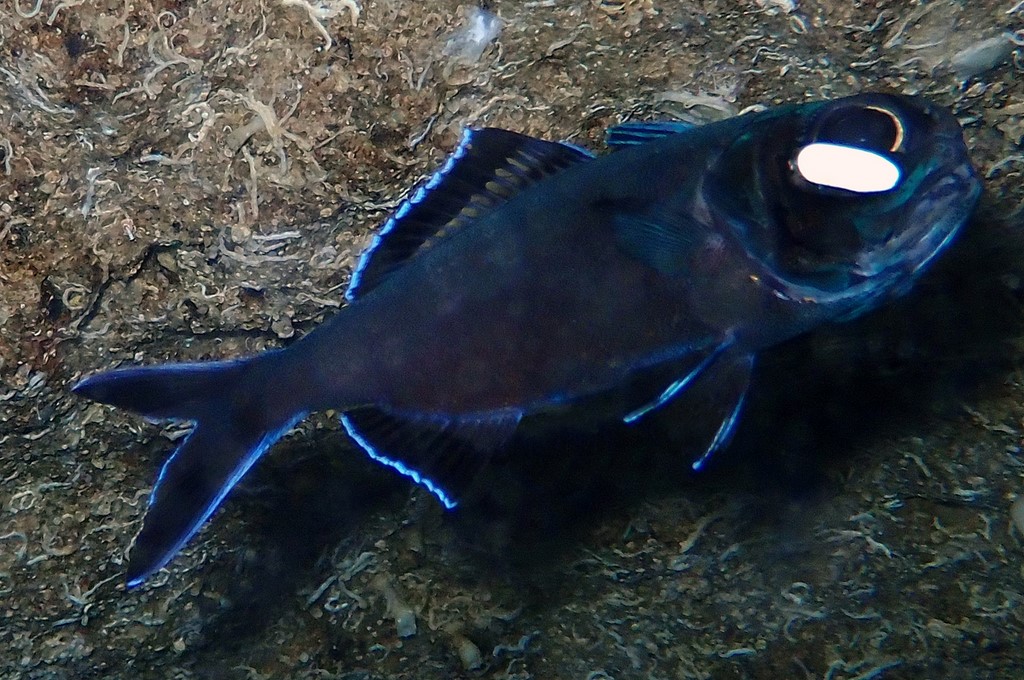ANOMALOPS KATOPTRON - (BLEEKER, 1856)
Picture courtesy of: Alain Daoulas
Actinopterygii (Gigaclass) > Actinopteri (Class) > Teleostei (Subclass) > Trachichthyiformes (Order) > Anomalopidae (Family) > Anomalops (Genus)
Grand poisson lanterne, Twofin flashlightfish, Two-fin flashlightfish, Great flashlightfish, Lantern-eye, Splitfin flashlightfish, Grosser Laternenfisch, Hikarikinmedai, ヒカリキンメダイ, 灯眼鱼, 燈眼魚, фонареглаз большой,
Synonymes
Anamalops katoptron (Bleeker, 1856)
Anamolops katoptron (Bleeker, 1856)
Anomalops graeffei (Kner, 1868)
Anomalops kaptoptron (Bleeker, 1856)
Heterophthalmus katoptron (Bleeker, 1856)
-------------------------
Description
Dorsal spines (total): 6-7; Dorsal soft rays (total): 14-15; Anal spines: 2; Anal soft rays: 9-11; Pectoral fin rays: 18; Lateral line nearly straight, the pored scales about: 59. Gill rakers on first arch: 28-34; Light organ length: 35.4% in Head Length; Light organ beneath eye rotatable (to cut off light); Eye very large: 2.5-2.7 in Head Length; Posterior edge of orbit with a series of papillae; Snout very short and blunt, half eye diameter; Caudal fin deeply forked. Depth of body: 3.0-3.3 in SL. Max. length: 35.0 cm TL. Depth range: 2 - 400 m.
Color
Dark purplish; Caudal fin black with a blue margin.
Etymology
Anomalops: from Ancient Greek, anomalos = uneven, irregular, anomalous, abnormal, exceptional + from Ancient Greek, óps = eye, face, appearance. Referring to two gland-like organs beneath its eyes, “to which no analogy among fishes is known”. In 1868, R. Kner was not aware that these glands were luminous.
katoptron: from Greek, kátoptron = mirror. Referring to inside of light organ enclosed by a guanine crystal reflector (although Bleeker was unaware of the specific structure and function of this reflector).
Original description: Heterophthalmus katoptron Bleeker, 1856 - Type locality: Manado, Sulawesi, Indonesia.
Distribution
West Pacific: Indonesia and Philippines to Mariana and Tuamotu islands and Ryukyu Islands (Japan) to Australia and New Caledonia.
Grand poisson lanterne, Twofin flashlightfish, Two-fin flashlightfish, Great flashlightfish, Lantern-eye, Splitfin flashlightfish, Grosser Laternenfisch, Hikarikinmedai, ヒカリキンメダイ, 灯眼鱼, 燈眼魚, фонареглаз большой,
Synonymes
Anamalops katoptron (Bleeker, 1856)
Anamolops katoptron (Bleeker, 1856)
Anomalops graeffei (Kner, 1868)
Anomalops kaptoptron (Bleeker, 1856)
Heterophthalmus katoptron (Bleeker, 1856)
-------------------------
Description
Dorsal spines (total): 6-7; Dorsal soft rays (total): 14-15; Anal spines: 2; Anal soft rays: 9-11; Pectoral fin rays: 18; Lateral line nearly straight, the pored scales about: 59. Gill rakers on first arch: 28-34; Light organ length: 35.4% in Head Length; Light organ beneath eye rotatable (to cut off light); Eye very large: 2.5-2.7 in Head Length; Posterior edge of orbit with a series of papillae; Snout very short and blunt, half eye diameter; Caudal fin deeply forked. Depth of body: 3.0-3.3 in SL. Max. length: 35.0 cm TL. Depth range: 2 - 400 m.
Color
Dark purplish; Caudal fin black with a blue margin.
Etymology
Anomalops: from Ancient Greek, anomalos = uneven, irregular, anomalous, abnormal, exceptional + from Ancient Greek, óps = eye, face, appearance. Referring to two gland-like organs beneath its eyes, “to which no analogy among fishes is known”. In 1868, R. Kner was not aware that these glands were luminous.
katoptron: from Greek, kátoptron = mirror. Referring to inside of light organ enclosed by a guanine crystal reflector (although Bleeker was unaware of the specific structure and function of this reflector).
Original description: Heterophthalmus katoptron Bleeker, 1856 - Type locality: Manado, Sulawesi, Indonesia.
Distribution
West Pacific: Indonesia and Philippines to Mariana and Tuamotu islands and Ryukyu Islands (Japan) to Australia and New Caledonia.
Biology
Hides during the day and venture out at night to feed, tending to occur along steep drop-offs near caves on dark, moonless nights. Feeds on zooplankton. The large, deep water form is occasionally collected by fishing at depths of 200 to 400 m. Caught with cast nets in shallow waters of the Philippines. Forms aggregations. It change their blink behavior in darkness to use their light organs as a light source to illuminate and find prey organisms. This fish can be found in the aquarium trade.
Similar species
Parmops coruscans (Rosenblatt & Johnson, 1991) - Reported from Tahiti Island (Society Islands).
Photoblepharon palpebratum (Boddaert, 1781) - Reported from New Caledonia.
Protoblepharon rosenblatti (Baldwin, Johnson & Paxton, 1997) - Reported from Cook Islands.
Similar species
Parmops coruscans (Rosenblatt & Johnson, 1991) - Reported from Tahiti Island (Society Islands).
Photoblepharon palpebratum (Boddaert, 1781) - Reported from New Caledonia.
Protoblepharon rosenblatti (Baldwin, Johnson & Paxton, 1997) - Reported from Cook Islands.
Last update: 9, September 2023
